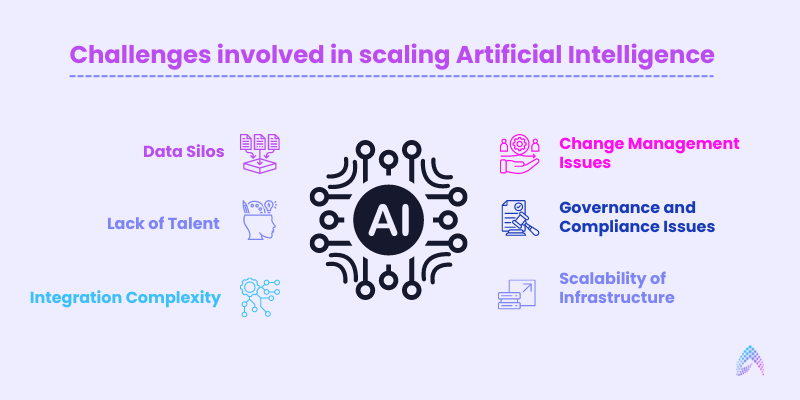The AI Scalability Roadmap: A 10 Step-by-Step Guide

Introduction
With the emergence of business and customer needs, AI has become a commodity for every business across industries. Moreover, it’s a no-brainer deal for every business owner aspiring to grow and stay ahead of the innovation curve.
According to a CISCO report, by 2035, AI technologies are projected to increase business productivity by up to 40%.
However, despite the growing AI investments, AI scalability across the enterprise presents significant challenges. Scaling AI isn’t just about deploying more and more algorithms; it’s about integrating AI into every aspect of your business operations.
This blog delves into the challenges involved in AI scalability and the best practices to follow to scale AI across the enterprise.
Challenges involved in AI Scalability

Getting one or two small and low-risk AI projects is very different from running an entire organization on AI. And as AI scales, problems can also scale, too.
For example, Amazon’s AI recruitment tool was completely shut down due to biases in data and gender discrimination. This is because of ML algorithm glitches in downranking women’s profiles.
Let’s take a look at the major challenges of scaling AI projects.
1. Data Silos:
Are you comfortable working in silos? If not, data silos aren’t an exemption. One of the significant obstacles to AI scalability is organization’s data silos. Data is often stored in disparate systems and formats across different departments, leading to fragmentation and a lack of cohesion.
This fragmentation prevents you from harnessing the full potential of your data for AI integration and scalability. When data is not easily accessible or unified, it complicates the AI training process, which requires large, diverse datasets to generate accurate and meaningful insights.
Consider a large healthcare organization that uses data spread across multiple departments. Each department uses its own software systems, leading to fragmented data that cannot be easily integrated and maintained for AI analysis. When the organization attempted to develop an AI model to predict patient outcomes, the data silos made it difficult to gather a comprehensive dataset, thereby limiting the accuracy and effectiveness of the AI model.
2. Lack of Talent:
AI-skills scarcity is another big challenge across industries. AI model development, deployment, and maintenance require data science, machine learning, and AI engineering experts. Unfortunately, with the limited AI talent pool, organizations are grappling to find and onboard the right talent.
This AI talent shortage can further slowdown AI scalability initiatives as organizations struggle to develop their AI strategies.
3. Integration Complexity
AI integration into an organization’s IT infrastructure is often technically challenging. AI systems must seamlessly integrate with current databases, software, and workflows, which can be complex and time-consuming.
With the disparities and incompatibility issues, AI implementation and deployment can create bottlenecks and hinder AI scalability.
If you are in the automotive industry, process automation is crucial to enhancing operations and minimizing downtime. However, your company’s legacy IT systems fail to support the AI algorithms, resulting in substantial integration challenges. The challenges of integrating AI systems with outdated machinery and software lead to delays and higher expenses.
4. Change Management Issues
AI adoption comes with a lot of skepticism around job security and reliability. Scaling AI within an organization is crucial, but the main challenges are the need for more communication among teams and stakeholders and resistance to change. Also, communication challenges among cross-functional teams are another hindering factor in scaling AI.
5. Governance and Compliance Issues
In the case of AI implementation and scalability, meeting country-specific governance and compliance standards remains a challenge. Failure to comply with these regulations can lead to legal penalties, reputational damage, and loss of trust from customers and stakeholders.
The latest USA 2024 Annual Regulatory Report from FINRA classified AI as an “emerging risk,” citing concerns about accuracy, privacy, bias, and intellectual property.
6. Scalability of Infrastructure
Your current IT infrastructure may need more capacity to support AI scalability initiatives on a broader scale adequately. AI applications often require significant computational power, storage, and bandwidth, which may necessitate substantial upgrades or even a complete redesign of the current infrastructure.
How to scale AI in your organization: 10 Steps to follow
1. Start with data science
To successfully scale AI projects, it’s crucial to prepare your data architecture and data to fulfill the specific requirements of the technology. This includes ensuring compatibility with large language models (LLMs), developing unstructured data processing capabilities, and enabling semantic search with vector databases for content discovery and updated data models. These measures are essential for driving successful outcomes and leveraging the full potential of the technology.
2. Identify the right data sets and formats
Data comes in various formats, including files, documents, transaction histories, and external resources such as market trends and reports. Make sure you have access to clean and structured data across the organization. Develop a centralized data ecosystem that allows your team to access the data repository anytime and anywhere while setting up the necessary access controls.
Create data lakes by simplifying the storage of vast amounts of raw data in their native format, making it easier to handle large-scale datasets and enabling flexible data processing. On the other hand, data warehouses can be optimized for query performance and provide valuable insights through complex data analysis.
Learn more about the significance of AI-powered data for business transformation.
3. Involve stakeholders
Though you start small, involve all stakeholders from various departments to develop and scale AI applications. Since every department has unique requirements and challenges, you need support from the respective department’s stakeholders to build custom AI solutions.
4. Manage the Data Lifecycle
AI applications require continuous data for training and decision-making purposes. So, develop secure and standardized data structures that integrate and update data sources. Managing the data lifecycle keeps data relevant and up-to-date for training and validating AI models.
In data processing, remember the rule of “garbage in – garbage out.” Poor data quality leads to inaccurate predictions and perhaps hinders your AI scalability chances.
5. Optimize and Simplify MLOps
Opt for an MLOps platform that aligns with your data science and IT teams while supporting your organization’s IT infrastructure and primary cloud provider. Embracing MLOps aligns DevOps principles with machine learning, creating a robust framework for seamless integration and deployment of AI models.
Data engineers are crucial in automating mundane tasks, minimizing errors, and guaranteeing swift and effective model deployment and upkeep. You can foster a culture of rigorous testing and validation by utilizing standardized libraries for AI model validation.
Techniques such as hyperparameter tuning, model pruning, and quantization to enhance model performance while reducing computational requirements can help you scale AI across your enterprise.
6. Assemble Cross-functional AI team
Build a team that includes data scientists, IT professionals, business analysts, and other teams to promote cross-departmental collaboration. This approach enriches AI initiatives and fosters a comprehensive understanding of business goals.
To truly unleash the power of AI, business leaders must cultivate and empower specialized teams. By allowing data scientists to focus solely on data science, engineers to delve into engineering, and IT to concentrate on infrastructure, organizations can drive forward with high-impact strategic initiatives tailored to their unique strengths.
7. Start projects with high success potential
Despite the buzz around AI implementation, its success rate is still low. Therefore, prioritize AI projects and initiatives that offer quick wins and high ROI to build momentum and demonstrate value. Example use cases can include an AI-powered chatbot for customer care services, invoice processing, IT ticket management, and so on.
8. Incorporate governance and compliance
Any misuse of AI can stake your business reputation and credibility. Establish governance frameworks to ensure ethical ai practices, compliant, and aligned with business objectives. Incorporate compliance and reportability into all AI processes to maintain ethical standards.
AI governance goes beyond basic security measures in an application. It carries the weight of upholding an organization’s ethical code, safeguarding against biases towards any specific group, and ensuring that decisions made by AI applications are reliable and trustworthy.
9. Use the right set of AI tools
Use cloud-based data science platforms and Artificial Intelligence tools to facilitate collaboration between data scientists, IT engineers, and other teams that support scalability and offer flexibility. Also, develop a test and set environment that allows your team to experiment with Artificial Intelligence (AI) implementation and scalability without disturbing regular operations.
10. Measure AI efforts
AI scalability is not just about deploying new models every week or month but also measuring their impact. Keep track of KPIs such as cost savings, revenue growth, customer satisfaction, and operational efficiency. Additionally, ROI can be measured by evaluating the financial impact of AI projects compared to a traditional approach.
JPMorgan Chase Success Story
Take the case of JPMorgan Chase, one of the largest financial institutions in the world. Initially, the company began using AI for narrow applications like fraud detection and customer service automation.
However, recognizing the potential for its broader impact, JPMorgan Chase decided to scale AI across its entire operations. Today, AI scalability across their operations empower everything from loan approval to personalized customer experiences, significantly improving efficiency, productivity, and profitability.
Of course, this transformation didn’t happen overnight – it required a structured approach, planning, execution, and refinement.
What’s next in AI scalability
Scaling AI applications across your organization is a complex task that demands a comprehensive understanding of AI implementation, evaluation of future potential, and consideration of ROI. Imagine AI scalability as a well-oiled machine, where every element is essential for seamless operation around the clock.
Neglecting to prioritize this critical component could have devastating repercussions on the seamless operation and reliability of the business. Therefore, we strongly recommend empowering your internal team with the necessary skills or partnering with an AI solutions provider who can alleviate the burden and ensure that your AI grows in tandem with your business.
Are you ready to leap into your AI implementation game?
Let’s collaborate and take your AI vision to the next level

President & CEO – Growth Markets




